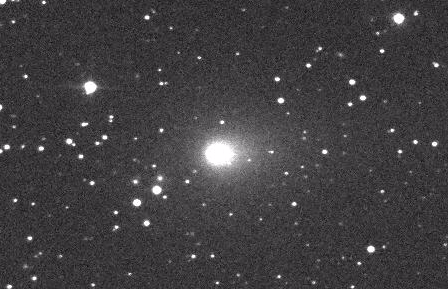Astronomy Picture of the Day
Discover the cosmos! Each day a different image or photograph of our
fascinating universe is featured, along with a brief explanation written by
a professional astronomer.
February 8, 1996

Hyakutake: The Great Comet of 1996?
Photo Credit and Copyright:
Gordon
Garradd. Used with permission.
Explanation:
Get ready for one of the most impressive but least anticipated light shows
in modern astronomical history. Next month, newly discovered
Comet
Hyakutake will pass closer to the Earth than any recent
comet. Unknown
before its discovery by Yuji Hyakutake on 30 January 1996, the fuzzy spot
in the above photograph is a
comet now
predicted to become bright enough to see without a telescope. Although
comets
act in such diverse ways that predictions are frequently inaccurate,
even conservative estimates indicate that this comet is likely to impress.
For example, even if
Comet
Hyakutake remains physically unchanged, its
close pass near the Earth in late March 1996 should cause it to appear to
brighten to about
3rd
magnitude - still bright enough to see with the unaided
eye. In the next two months, though, the
comet
will continue to approach
the Sun and hence should become brighter still. Optimistic predictions
include that
Comet Hyakutake
will change physically, develop a larger
coma and
tail,
brighten dramatically, move noticeably in the sky during a single
night, and may ultimately become known as the "The Great Comet of 1996."
Move over Hale-Bopp!
Tomorrow's picture: In the Eye of an Hourglass Nebula
| Archive
| Index
| Glossary
| Education
| About APOD |




Authors & editors:
Robert Nemiroff
(GMU) &
Jerry
Bonnell (USRA).
NASA Technical Rep.:
Sherri
Calvo.
Specific rights apply.
A service of:
LHEA
at
NASA/
GSFC




